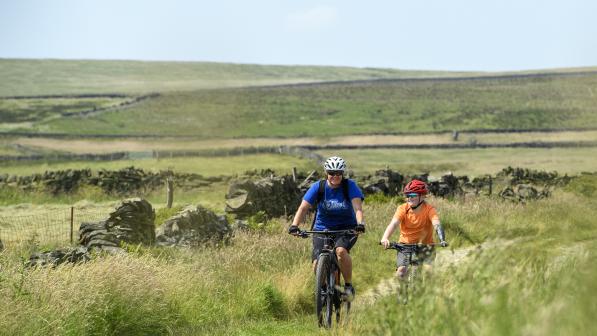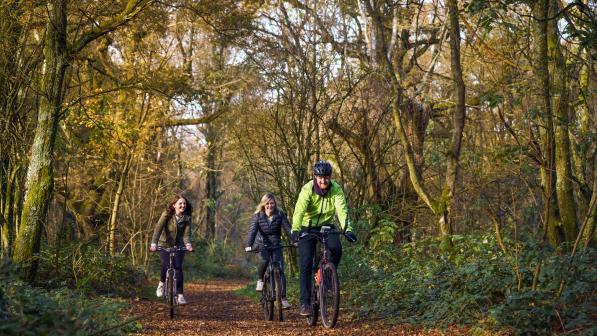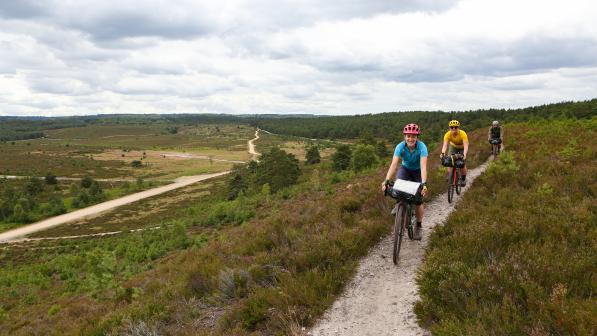Missing Links: FAQ

What are you trying to achieve?
Cyclists can already use bridleways and byways, why are you asking for more access?
How can I add routes to the map?
What happens when I add a route to the map?
Why is this campaign England-only?
What is Cycling UK doing to encourage off-road cyclists to be considerate to others?
What are you trying to achieve?
We want to identify the routes that could fill in the gaps for off-road cycling. In many places, opening up one short stretch of path could connect a much longer route.
At a time when many people are rethinking their travel habits and the Government in Westminster is keen to get more people cycling, it’s a perfect opportunity to consider how we can make use of existing trails, paths and tracks to create safe routes.
At the moment, many routes don’t join up. Having to ride on a section of busy road can be intimidating, especially for less confident cyclists.
With a combination of upgrading existing rights of way, rejuvenating disused railway lines, and traffic calming on some rural lanes, we can link up these routes to form a network of traffic-free trails – as we explained in our Beyond the Green Belt vision.
We want to make it easier for people to suggest improvements, so local authorities can incorporate them into future planning.
Cyclists can already use bridleways and byways, why are you asking for more access?
Of the 118,000 miles of rights of way in England, only 22% of those are open to cyclists and horse riders. Behind this average lies wide variation across the country – Surrey and Shropshire, for example, have a comparatively well-linked network of bridleways and byways, whereas in Derbyshire they can be few and far between.
The disjointed nature of the bridleway and byway network can make it difficult to put together a route. A bridleway might come to an end at a busy main road, with the route on the other side having been recorded as a footpath as it crosses a parish boundary.
Cycling UK and OpenMTB’s 2017 Rides of Way survey revealed that almost half of riders believe the current rights of way system makes it hard to put together a route. Making more footpaths, which are suitable for upgrade, multi-use would make it easier to plan routes and avoid busy roads, and enable more people to explore the countryside.

How can I add routes to the map?
The map on the main Missing Links web page only displays the routes, but you can use the editable map to add your own – there are instructions above the map. It will automatically save anything you add.
What happens when I add a route to the map?
Councils aren’t automatically notified when routes are added to the map in their area, so it’s important that once you’ve added things to the map, you remember to do the next step of sending an email to your council to tell them about your route and ask them to look at the other suggestions on the map.
As more routes are added to the map, it will start to build up a picture of how a strategic network could develop.
Why is this campaign England-only?
Access laws vary across different nations. Scotland’s Land Reform Act 2003 allows responsible access to most land provided people follow the Outdoor Access Code.
In England and Wales, only one fifth of rights of way are available for cycling and horse riding. However, change is afoot in Wales, as the Welsh Government is developing legislation to make many rights of way multi-use following campaigning by Cycling UK, OpenMTB and others.
Proposals for similar legislative changes have not made as much progress in England, but with the Westminster Government outlining a new vision to increase levels of cycling, it’s a good opportunity to highlight the potential of existing off-road paths and tracks to enable people to explore by bike and connect with nature, and suggest which routes could be prioritised for cycle access.
Changes to rights of way involve complex legal processes – will suggesting changes actually achieve anything?
The fact that the current system is so complex is exactly why we wanted to provide a place for people to make suggestions about routes they wish they could ride on, but don’t know what to do about it. If you’re not sure whether your missing link is a right of way, a permissive path, or an unsurfaced road, how do you know who to talk to?
Councils' rights of way teams (or in some cases, a single rights of way officer), have often been under-resourced for many years, so the aim of this campaign is not to be critical of councils. Many will understandably say they don’t have the capacity to instigate additional changes above the day-to-day workload.
Instead, we as individuals need to become part of the solution – by becoming involved with Local Access Forums, contributing to Rights of Way Improvement Plans when they are consulted upon, and helping to show why improving access to the countryside, upgrading rights of way, and connecting missing links is important and should be properly resourced.
What else can I do?
If you want to do more to promote responsible off-road access for cycling in your area, there are lots of ways you can get involved:
- Join your Local Access Forum to contribute to discussions about countryside access from a cycling perspective.
- Join the Cycle Advocacy Network to connect with others in your area and find advice and information.
- Create or join a mountain biking advocacy group to build positive relationships with councils and landowners, to figure out solutions to any problems before they become a big issue.
- Research historic rights of way to add to the definitive map.
- Have a look at Cycling UK’s advice for off-road campaigning.
- Subscribe to Cycling UK’s off-road updates to find out more about off-road campaigns.
- Get in touch at [email protected] if you want to get involved another way.
What is Cycling UK doing to encourage off-road cyclists to be considerate to others?
Cycling UK has collaborated with the British Horse Society to educate cyclists about how to pass horse riders safely, and to promote the ‘Be Nice, Say Hi’ campaign started by mountain biking advocacy group Ride Sheffield, which encourages all users to be considerate and friendly while enjoying the outdoors.
We also promote the codes of conduct for mountain biking and for shared use paths.




